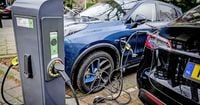In a significant move aimed at revitalizing the electric vehicle (EV) market, the Dutch cabinet has announced plans to overhaul the motor vehicle tax (mrb) system. This change, set to take effect after 2030, will shift the basis for taxation from the weight of vehicles to their surface area, a decision that could have far-reaching implications for electric car owners and the automotive industry.
Currently, electric vehicles, which are generally heavier due to their battery packs, face higher road taxes compared to their gasoline and diesel counterparts. This tax structure has been criticized for potentially stifling the growth of the EV market, as the financial burden may deter consumers from choosing electric options. The upcoming reform aims to address this issue by ensuring that the road tax is calculated based on the length and width of the vehicle rather than its weight. According to De Telegraaf, this change is part of the broader climate measures package proposed by Minister Hermans, which seeks to encourage the adoption of electric vehicles.
The decision to reform the mrb is timely, as the current system has been increasingly seen as a barrier to the adoption of electric vehicles. With the fiscal discount on road tax for electric car owners set to expire in the long term, the cabinet's move is viewed as essential to maintain the attractiveness of electric vehicles in the market. Until last year, owners of fully electric cars did not pay any road tax, but this has changed. However, they can expect a fiscal discount in the coming years, which is set to increase from 25% to 30% next year, as reported by De Telegraaf.
By shifting the tax calculation to focus on the vehicle's surface area, the cabinet aims to create a more equitable system that does not disproportionately penalize electric vehicle owners. This means that while larger electric cars may still incur higher taxes, those who opt for smaller, more reasonable-sized vehicles will find their tax burdens more in line with those of gasoline-powered cars of similar dimensions.
The announcement comes at a critical juncture as the global automotive industry grapples with the transition to electric mobility. With governments around the world pushing for greener alternatives to traditional combustion engines, the Dutch cabinet's decision reflects a growing recognition of the need to adapt taxation policies to support this shift. The current tax structure, which heavily penalizes heavier vehicles, could discourage consumers from making environmentally friendly choices.
Moreover, the cabinet has nearly five years to finalize the calculations and implement the new tax structure, allowing for ample time to develop a system that balances revenue needs with the promotion of electric vehicles. The goal is clear: to create a taxation framework that incentivizes consumers to choose electric cars without compromising the government's revenue from road taxes.
This initiative is not just about taxation; it is also part of a broader strategy to tackle climate change and reduce greenhouse gas emissions. By making electric vehicles more financially attractive, the government hopes to accelerate the transition to a more sustainable transportation system. This aligns with the European Union's ambitious goals to cut carbon emissions and promote cleaner energy sources.
The implications of this reform extend beyond just the tax structure. It signals a shift in how governments view electric vehicles and their role in the future of transportation. As the market for electric vehicles continues to expand, it is crucial for policymakers to create an environment that supports innovation and encourages consumers to make the switch.
In conclusion, the Dutch cabinet's decision to overhaul the motor vehicle tax is a pivotal step in supporting the electric vehicle market. By basing taxes on the surface area of vehicles rather than their weight, the government aims to create a more equitable system that encourages the adoption of electric cars while still generating necessary revenue. As the automotive landscape evolves, such measures will be vital in ensuring that electric vehicles remain a viable option for consumers, helping to pave the way for a more sustainable future.


